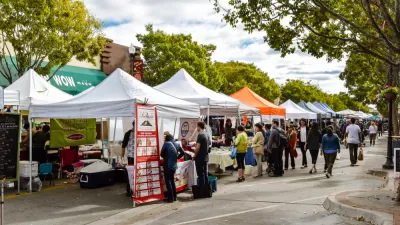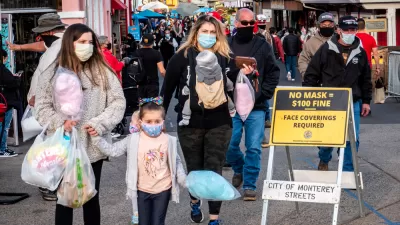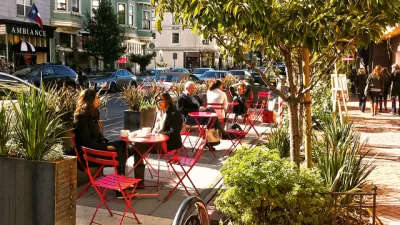Gov. Newsom's unexpected announcement that the pandemic would end on June 15 led one city to consider reopening its al fresco street and parklets to motor vehicles. After hearing from the public, the city council sided with diners over drivers.

[Contributor's note: This post is a continuation of the recent post, "Outdoor Dining a Victim of its Own Success in One Wealthy Bay Area City," which set the stage for a meeting of the San Carlos City Council to act on their planning staff's recommendation to terminate the al fresco programs and reopen a closed street to traffic and the parklets to motor vehicle parking to coincide with the California governor's reopening order.]
Actions have consequences. Gov. Gavin Newsom's surprise announcement on April 6 that he plans to terminate California's successful coronavirus 'blueprint' reopening program on June 15 may have significant impacts on Covid-19 response planning decisions made by local governments. Case in point: San Carlos in the Bay Area.
Street closure begins in June 2020
Like other cities throughout the country, the city of just less than 30,000 people nestled between Belmont and Redwood City on the San Francisco peninsula had adapted streets in its commercial district [pdf] in June 2020 to permit outdoor (al fresco) dining, closing two blocks of Laurel Street to vehicular traffic, and displacing vehicular parking by permitting dining parklets to ensure the economic survival of local restaurants struggling to comply with local and/or state-imposed coronavirus restrictions that banned or limited capacity of indoor dining, depending on the level of coronavirus incidence in San Mateo County.
The city's temporary street closure and parklet programs were set to terminate on December 10, 2020. On Nov. 9, the council voted 3-2 to continue the program to Sep. 1, 2021, reported Sierra Lopez for the (San Mateo) Daily Journal, similar to the continuation of other al fresco street programs in Peninsula cities cited in the article, including Burlingame, San Mateo, Belmont, Redwood City and Palo Alto.
Third surge
The timing was good. Coronavirus infections were increasing nationwide in the fall, beginning the state's third and most deadly surge that would eventually even shut down outside dining in most of the state due to Gov. Gavin Newsom's Regional Stay at Home order issued on Dec. 3.
The state, which became the epicenter of the pandemic in the U.S. in early January with most hospitals overwhelmed by COVID-19 patients, slowly began to emerge from the outbreak. The Regional Stay at Home Order was lifted by the California Department of Public Health on Jan. 25. The restrictions had worked beyond expectations, but the surge had taken its toll – daily deaths had peaked in late January at almost 600 daily.
The regional order was replaced by the county-by-county blueprint on Jan. 25. Cases have continued to drop. The Golden State has the second-lowest case incidence in the U.S., 4.9 per 100,000 people, after the Northern Mariana Islands with 0.5 per 100k, according to Covid Act Now on April 27.
Governor's reopening announcement takes local governments by surprise
San Carlos Mayor Laura Parmer-Lohan, along with other council members, hadn't counted on Gov. Newsom's sudden announcement on April 6 that he would scrap the county-by-county reopening blueprint and open up all 58 counties, regardless of their health metrics.
"I had the same questions about Gavin Newsom's announcement [as Council Member Ron Collins], the fact that it was quite unexpected because I recall when we discussed...the September 1 date back in the fall, it was based on [Anthony] Fauci's prediction that we would likely be reopening around that time and so the June date came as quite a surprise," said Parmer-Lohan during the April 12 meeting held remotely via Zoom.
As the San Francisco Chronicle opined on April 6, the June 15 reopening date may have been "driven by polling data," referring to a likely gubernatorial recall election, rather than coronavirus metrics. On April 26, the California Secretary of State announced that "the requisite number of valid signatures [pdf] has been reported to our office to initiate the recall of Governor Gavin Newsom."
City council rejects planning staff's recommendation
The recommendation to the 5-member San Carlos City Council in their staff report (click on Agenda #9a), written by the Planning Division of the Community Development Department, for the April 12 meeting was to terminate the program to coincide with the governor's statewide reopening date rather than continue to September per the council's vote last November.
RECOMMENDATION:
In response to rising safety concerns and an anticipated statewide reopening order from the Governor, staff recommends the City Council consider a Resolution terminating the temporary closure of Laurel Street and ending the temporary parklet outdoor dining program, including direct termination of encroachment permits effective June 15, 2021.
"Councilmembers largely agreed with public comments to maintain the program as is, citing an interest in continuing support of restaurants after the long year of losses," reported Lopez on April 14 for the Daily Journal (source article).
[Vice-Mayor Sara] McDowell also noted families with unvaccinated children will need outdoor dining as an option well into the fall.
Councilmembers also noted they’d each received more than 170 emails over the weekend and McDowell said only five were negative.
Several restaurateurs made the point that the majority of their customers explicitly state they will only eat outdoors for viral safety purposes. One owner also noted that they were counting on operating outdoors till Sept. 1.
“The outdoor dining program has been a huge success for every restaurant in the city. We would be gone if it didn’t exist,” Steve Salazar, the owner of Sneakers American Grill, said. “To change it midstream is really kind of unfair and kind of a stab in the back to the restaurants downtown.”
Speaker after speaker rejected the staff recommendation, with many advocating that the street closure and parklets be made permanent. One speaker openly questioned why the staff report lacked that consideration among the four options offered. No speakers supported the June closure date.
Council Member John Dugan indicated that the majority of people he's spoken with want the Laurel Street closure to be made permanent, echoing the point made by some speakers that it gave a European feel to their downtown.
A motion was made by Council Member Adam Rak to make no changes to the termination date of the program of Sept. 1 and that the downtown subcommittee devises medium or long term plans for what is now a temporary street closure and parklet program by June 15, the date when the pandemic ends in California. It passed unanimously.
Related in Planetizen:
- Pandemic to End in California on June 15, Governor Decides, April 21, 2021
- Outdoor Dining a Victim of its Own Success in One Wealthy Bay Area City, April 20, 2021
- Op-Ed: Don't Reverse the Progress Made by 'Pandemic Streets', April 19, 2021
- How to Maintain Open Streets After the Pandemic, March 29, 2021
- Feature: The Post-Pandemic Street, December 22, 2020
- Blog Post: The Growing Footprint of Al Fresco Streets, May 28, 2020
FULL STORY: San Carlos continues street closure program; City Council considers reimagining for Laurel Street’s future

Maui's Vacation Rental Debate Turns Ugly
Verbal attacks, misinformation campaigns and fistfights plague a high-stakes debate to convert thousands of vacation rentals into long-term housing.

Planetizen Federal Action Tracker
A weekly monitor of how Trump’s orders and actions are impacting planners and planning in America.

Chicago’s Ghost Rails
Just beneath the surface of the modern city lie the remnants of its expansive early 20th-century streetcar system.

Bend, Oregon Zoning Reforms Prioritize Small-Scale Housing
The city altered its zoning code to allow multi-family housing and eliminated parking mandates citywide.

Amtrak Cutting Jobs, Funding to High-Speed Rail
The agency plans to cut 10 percent of its workforce and has confirmed it will not fund new high-speed rail projects.

LA Denies Basic Services to Unhoused Residents
The city has repeatedly failed to respond to requests for trash pickup at encampment sites, and eliminated a program that provided mobile showers and toilets.
Urban Design for Planners 1: Software Tools
This six-course series explores essential urban design concepts using open source software and equips planners with the tools they need to participate fully in the urban design process.
Planning for Universal Design
Learn the tools for implementing Universal Design in planning regulations.
planning NEXT
Appalachian Highlands Housing Partners
Mpact (founded as Rail~Volution)
City of Camden Redevelopment Agency
City of Astoria
City of Portland
City of Laramie





























